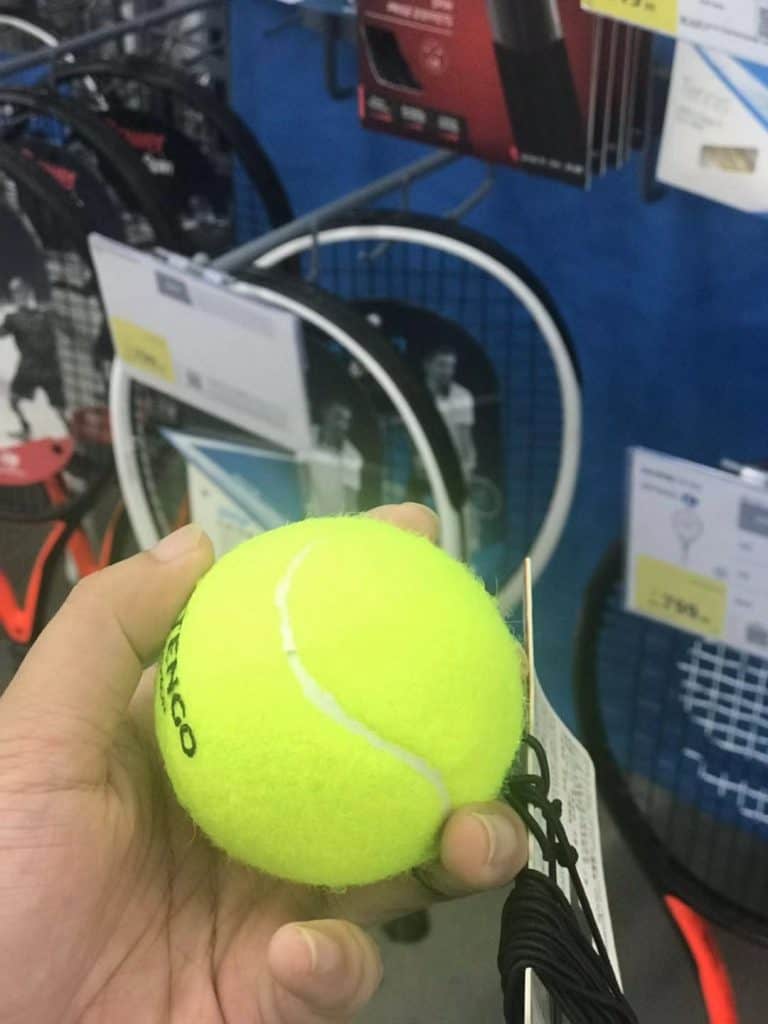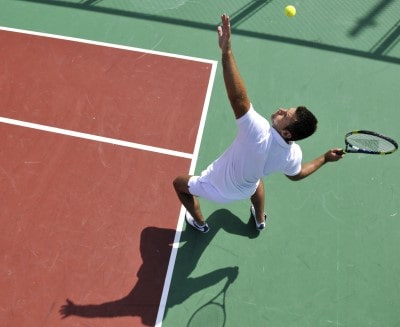If you are in a hurry and just want to find out what the best tennis ball is, then we recommend the Slazenger Wimbledon Official Tennis Ball as the best one.
Happen to be looking for the best tennis balls available out there? You are in the right place.
Below, we are going to offer to your attention 5 tennis balls to choose from. And to make your decision-making process easier and quicker, we are going to talk about what matters in tennis balls.
Let’s get started!
In this article, we’re going to review the following tennis balls:

I’m choosing tennis balls
How to choose tennis balls
Types of tennis balls
Tennis balls can be categorized based on various criteria, the most important of them being ball speed. We’ll talk about the other criteria a little later, but now, let’s focus on ball speed.
There are 3 tennis ball speeds out there:
- Slow or Type 3. Have a larger diameter (7-7.3 cm or 2.76-2.87 inches) than other balls and are better for slow players. Besides, these balls slow down play on fast courts.
- Medium or Type 2. The most commonly used ball speed. Works well for most players in the majority of situations. Smaller than slow balls (6.54-6.86 cm or 2.57-2.7 inches)
- Fast or Type 1. These balls are rarely used in competition. Usually, fast tennis balls are used on slow clay tennis courts. Sized the same as medium balls.
Prior to recent regulation changes, only medium-speed balls were allowed for competition. To even out the game across different court types, fast and slow balls were allowed to be used by the ITF.
Tennis ball levels
Tennis balls are also sometimes categorized as competition (or professional) or recreational balls.
Competition balls need to comply with certain rules introduced by the International Tennis Federation:
| Fast/
Type 1 |
Medium/
Type 2 |
Slow/
Type 3 |
|
| Weight | 1.975-2.095 oz | ||
| Size | 2.57-2.70 inches | 2.76-2.87 inches | |
| Rebound | 54-60 inches | 53-58 inches | |
| Return deformation | 0.291-0.425 inches | 0.315-0.425 inches | |
| Forward deformation | 0.220-0.291 inches | ||
| Color | White or Yellow | ||
A ball that satisfies these requirements is considered a competition tennis ball.
As for recreational tennis balls, there isn’t a strict definition of balls that are designed for recreational tennis. Usually, recreational balls are those that aren’t compliant with regulations and thus can only be used outside of competition. However, competition balls can also be used for recreation, and this should be done by people who are planning to enter professional tennis so that they can get used to the feel of real competition-compliant balls.
Pressureless vs pressurized
Tennis balls can also be pressurized and pressureless.
Pressurized tennis balls are used most commonly in competition. They are stiffer and bounce higher than pressureless balls when brand-new. However, they live shorter than pressureless balls, which makes them less cost-efficient over the long run.
Pressureless balls have a lower bounce, but they maintain it at a steady level for a longer time than pressurized balls. Thus, they are preferred by casual and recreational players due to their cost efficiency.
Regular-duty vs heavy-duty
Tennis balls have an external felt covering that protects their insides. This external felt can be regular-duty and heavy-duty.
Regular-duty balls sometimes referred to as soft-court tennis balls, are designed for use on softer-surface clay courts. These balls have a less fuzzy felt covering that picks up less clay, as well as makes the ball slower on clay courts.
Extra-duty or hard-court tennis balls are designed for use in the grass and hard courts. They have a thicker felt covering with more fuzz on it, which makes them more resistant to abrasion.
High altitude
At higher altitudes, regular tennis balls are bouncing higher, and sending long serves is easier. That’s because of the decreased atmospheric pressure at higher altitudes. Due to this, there exist high-altitude tennis balls that are designed to compensate for the decreased pressure at altitudes higher than 4,000 feet. ITF regulation-compliant high-altitude tennis balls have the exact same size, weight, and deformation as fast and medium balls, but they have a lower rebound.
Durability
Durability is also key in tennis balls, but it isn’t easy to assess before actually using a ball for some time. However, what you could do in order to extend the durability of your tennis ball is to use a tennis ball in the setting that it is designed for. For example, use a regular-duty ball only on clay courts since it will quickly deteriorate on hard-surface courts.
By the way, the ITW has certain ball durability requirements for tennis balls. A competition tennis ball needs to satisfy these criteria during a durability test:
- Maximum weight change of 0.014 oz.
- Maximum rebound change of 1.6 inches.
- Maximum forward deformation change of 0.031 inches.
- Maximum return deformation change of 0.039 inches.
For beginners and kids
Tennis balls can also be categorized as a beginner and kids’ balls.
Strictly speaking, specialty beginner tennis balls aren’t a thing. However, beginners usually play with slow tennis balls since they are bigger and easier to hit. Plus, since these balls are slower, they don’t require as quick of a reaction from tennis players.
On the other hand, there is such a thing as kids’ tennis balls. The ITF specifies 3 types of tennis balls that can be used in 10 and under tennis competitions:
- Stage 3/Red. Used in mini tennis.
- Stage 2/Orange. Used on 3/4 length courts.
- Stage 1/Green. These balls are slightly lower bouncing than regular tennis balls.
If you have a kid who wants to engage in professional tennis, make sure that they train with one of these ball types.
Best tennis balls reviewed
1. Wilson US Open Regular-Duty Tennis Ball
Up first on our list, we’d like to introduce you to Wilson’s US Open regular-duty tennis ball, which is the official ball of the US Open.
This tennis ball seems to be more of a middle-end tennis ball – it offers good performance for skilled tennis players, but players oriented at maximum performance will probably find them average. Well, they are priced quite reasonably for the delivered performance, so this isn’t a problem.
The Wilson US Open tennis ball is made for regular-duty use on clay or indoor courts. And while indoor and clay courts aren’t as demanding on tennis balls as outdoor hard-surface courts, Wilson still encased this ball in their long-lasting Tex Tech industries felt.
You could thus expect quite good longevity from this tennis ball. Add to that the fact that this product comes with a can of 3 balls, and you should get a pretty long service time out of this offer.
In the end, the Wilson US Open tennis ball is a good bang for the buck for players who want a more middle-performance tennis ball for clay or indoor courts.
Pros:
- USTA- and ITF-approved.
- The official ball of the US open.
- Made for use on clay or indoor courts.
Cons:
- Not the best pick for performance-oriented players.
2. Penn Championship High-Altitude Tennis Balls
The Penn Championship tennis ball is completely different. Not only is it a more durable and high-performance ball than Wilson’s US Open ball, but it also is designed for use at altitudes over 4,000 feet. The high-altitude nature makes this ball very specific in use – it has a lower bounce than regular balls, so it shouldn’t be used at lower altitudes.
So why is this ball’s durability better than in the Wilson tennis ball? Well, first of all, this is an extra-duty ball designed for use on hard courts. Aside from that, this tennis ball features interlocked wool fiber in the felt for increased durability. The fiber is released in a controlled manner in order to provide an even nap, while natural rubber reduces shock and offers a consistent feel of the ball.
A testimony to the durability of this ball is the feedback of users – with some of them, even dogs biting on the ball couldn’t damage the felt for weeks! These balls certainly aren’t made for biting and chewing by dogs, but this really speaks of the durability of this ball.
Pros:
- Designed for high-altitude use.
- Durable extra-duty covering felt.
- The official ball of USTA Leagues.
- USTA- and ITF-approved.
3. Dunlop Championship All-Court Tennis Ball
The Dunlop Championship Tennis Ball, as suggested by the product name, is designed for use on a variety of court types, be they indoor or outdoor. If you don’t have specific tennis needs and just want a ball to play tennis with, the Dunlop 3-pack may be an excellent option for you.
The versatility of this ball is its key feature – whether you are a beginner, a recreational player, or a more skilled player, this ball has balanced performance to offer. In fact, no matter what kind of a player you are, these balls allow for advancement into professional tennis since they are approved by the USTA and ITF.
On the other hand, the Dunlop Championship All-Court tennis ball definitely isn’t suitable for players who have specific needs. For example, if you mostly play on hard courts, then you should instead opt for the hard-court version of this ball. Each court type has its own specific requirements for ball surface and durability, and a ball like this cannot possibly be excellent for any type of court surface.
Pros:
- Suitable for the recreational and serious player.
- Designed for use on all court types.
- USTA- & ITF-approved.
Cons:
- Won’t be good for specific needs.
4. Wilson US Open Extra-Duty Tennis Balls
These Wilson US Open balls seem to be an extra-duty version of the regular-duty Wilson balls we’ve overviewed in the beginning.
This product is an excellent choice for players who need a plentitude of tennis balls for a good price. The particular offer we based our review on included 24 cans with 3 balls each, making for 72 balls overall. While the price tag of this offer is much higher than that of 3-ball cans, purchasing in a bulk is going to be more cost-efficient for you.
These tennis balls have an extra-duty felt, so they are going to be suitable for hard court surfaces only. And unlike the regular-duty Wilson balls that had middle-end performance among regular-duty balls, these seem to perform better in their hard-court niche. So if you happen to be looking for a high-performance hard-court ball, this pack should be a good one.
Pros:
- Extra-duty felt.
- Includes 72 tennis balls.
- The official ball of the US Open.
- ITF- & USTA-approved.
Cons:
- Pricey
5. Slazenger Wimbledon Official Tennis Balls
And the last product on our review of best tennis balls is Slazenger Wimbledon Official Tennis Ball. This product is a pricey one compared to other tennis balls on the list, but it is an excellent choice for amateurs looking for a durable ball and professionals who demand performance.
The Slazenger Wimbledon tennis ball features the so-called Tour Core that is engineered to deliver consistently great performance on all court surface types. In addition, the woven felt of this tennis ball made from the finest wool is designed specifically to satisfy the demands of the most prestigious tournament of the tennis world.
Remarkably, this tennis ball uses a unique Ultra Vis dye that ensures optimum visibility for players, as well as for spectators. Aside from that, Slazenger has used its Hydroguard technology to allow this ball to repel up to 70% of the water to achieve increased durability.
All in all, the Slazenger Wimbledon Official Tennis Ball costs more than many other balls out there, but it does seem to deliver excellent performance for the money.
Pros:
- Great ball for amateur and professional use.
- The official Wimbledon tennis ball.
- Offers excellent visibility for players.
- Can be used on all surfaces.
Cons:
- Pricier than others can offers.
Conclusion
Our personal pick from the top 5 is the Slazenger Wimbledon Official Tennis Ball. This ball combines in it the features and specs that make it comply with the stringent requirements of the world-renowned Wimbledon Tournament. And this does speak highly of the quality of this tennis ball.
What we also particularly liked about the Slazenger Wimbledon ball is that it is made for a wider range of players thanks to its all-surface suitability. While we don’t think that this is the highest-performance tennis ball in the world – narrowly specialized tennis balls are probably going to do better in hard or soft courts – it does offer a remarkable balance between price and features.
The above doesn’t mean that the rest of the tennis balls overviewed aren’t worthy of consideration. We wouldn’t include them in our top if they were. But we felt that the Slazenger Wimbledon ball was a little bit better than the others.








